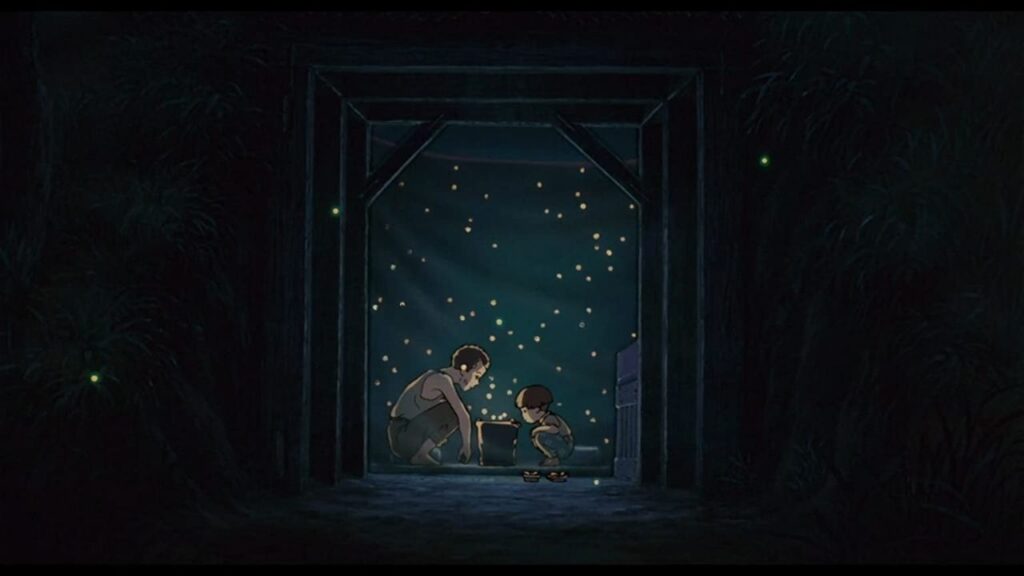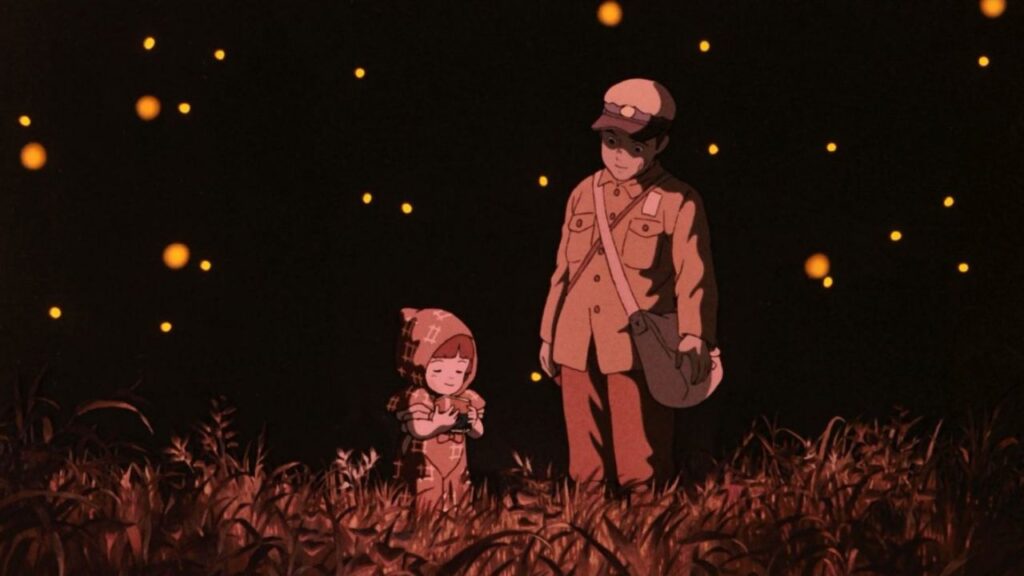Today’s post includes a brief plot summary, an explanation about the ending of the film Grave of the Fireflies / Hotaru no Haka (1988) and the true story behind the film. Beware of spoilers.

Directed by Isao Takahata, the 1988 Japanese anime drama is based on Akiyuki Nosaka’s novel of the same name. Today’s post is solely based on the film, not the novel.
Grave of the Fireflies (1988) – Plot Summary
Shortly after the end of World War II, a young teenage boy named Seita dies at a train station. A janitor passes by and checks for the boy’s belongings. The man eventually finds an old candy tin, but decides to throw it away. Meanwhile, the spirit of a young girl (Setsuko) appears from the candy tin. Seita and Setsuko reunite and the siblings board on a train.
During World War II, the siblings lose their house, the bombings were gradually destroying their entire city. Although they manage to escape, their mother ends up dying from severe burns. Without any close relatives to take care of them, Seita and Setsuko end up living with a distant aunt. The woman encourages Seita to sell his mother’s kimonos in exchange for some rice and the boy complies.
As time passed by, the aunt becomes increasingly hostile towards the siblings due to food scarcity. Incapable of coping with his aunt’s constant negative remarks, Seita and Setsuko move into an abandoned shelter.
The siblings bring a couple of fireflies into the shelter to get some light. However, the morning after Setsuko finds out that the fireflies are dead. Upset, the little girl digs a small grave and buries them. At this point, Setsuko is aware that her mother is dead.
Unable to buy food, Seita starts stealing from local farmers and looting homes during bombings. One day, a local farmer catches Seita stealing his crops and severely beats the young teenager. Nonetheless, the local police decides to let Seita go.
Due to constant famine, Setsuko is already showing signs of malnutrition. Seita takes her to doctor, but to no avail. No one around them is willing to help. Desperate, Seita withdraws all her mother’s money to buy some food supplies. As he walks out, Seita learns that Japan has lost the war. With most of Japan’s navy gone, the boy’s father is presumably dead as he was a captain at the Imperial Japanese Navy.
Seita returns to shelter with food and finds Setsuko on her last dying breath. He rushes to feed her some watermelon, but Setsuko dies before Seita finishes preparing her a full meal.
After Setsuko’s death, Seita cremates his sister in a straw casket and collects some of her ashes to put inside a candy tin. When Seita dies, the siblings’ spirits reunite and overlook their city with a present-day view.
Grave of the Fireflies (1988) – Ending Explained
The Grave of the Fireflies tells us the story of two children doing their best to survive during extremely difficult times. Having said that, why did they die? In a modern day context, it seems almost unreal and hard to understand how things could have escalated to this point. However, Seita and Setsuko were children from different times.

Who was responsible for Seita and Setsuko’s death?
Seita and Setsuko didn’t ask to be orphans, war took their parents away from them. Was the aunt the bad guy in this story? She definitely didn’t help, but she wasn’t the culprit for the two children’s death. When Seita decided to leave his aunt’s house, that was almost a death sentence for him and his sister. Having said that, did Seita make the wrong decision? The boy made a decision.
So did Seita doomed Setsuko? Blaming Seita for Setsuko’s death is not fair, because they were both children. In other words, the siblings didn’t know any better. Had Seita known what the real world was like, he wouldn’t have step a foot outside of his aunt’s house. Despite of aunt’s hostile attitude, Seita and Setsuko had a place to sleep and eat. It wasn’t much, but it was enough to keep them alive.
Why did it take so long for Seita to take Setsuko to the doctor? Again, Seita might be older than Setsuko, but he’s still a kid. Had he known the severe consequences of malnutrition, he would have gone back to his aunt’s house to ask for help.
During times of war the system simply does not work. There shouldn’t be scarcity of food, children should be with their parents and people should be more helpful towards each other. However, there was none of that in the Grave of the Fireflies. Let’s start with the aunt. Why was she so resentful towards the siblings? They were not her children. Let’s face it, generally speaking, when times are rough people taking care of other people’s children will never be as nice as if they were their own.
What about that doctor that saw Setsuko? Why didn’t he do something to help the girl? At that point, Setsuko was already suffering from severe malnutrition and without the possibility of being able to eat (on a constant basis), there wasn’t much that the doctor could do for the little girl. The whole country was starving, some more than others, due to food scarcity. The food rationing system only allowed each family to have a certain amount of food supply. Once Seita cut ties with his aunt, he and Setsuko were basically out of that system.
Money wasn’t the problem, because Seita had money. Nonetheless, none of that matters when the government is the one in charge of all the food supply nationwide. There’s no free market economy any more. That’s why the old man refused to sell some rice to Seita. The farmer knew that once he sells the remaining rice supply to the boy, he won’t have any left for himself.
Did pride get in the way? If Seita wasn’t so prideful, would things have end up differently? Maybe. There were a lot of wrong decisions in Grave of the Fireflies based on pride. The most obvious one is Seita’s decision to leave his aunt’s house. The second bad decision was the aunt letting the children leave her house.
Had Seita stayed a little longer in his aunt’s house, he would’ve had the bare minimum to survive: food and a clean place to live. At the abandoned shelter, the siblings had more freedom but they also had poorer living conditions. Having said that, the aunt should’ve known better. How are two kids going to make it in the real world all by themselves? Not to mention, there’s a war going on and food is scarce. That woman shouldn’t have let those kids go.
The Dangerous Side Of Nationalism
The most tragic part in the film wasn’t Seita and Setsuko’s death, but watching how broken the system was. There was very little kindness from people during those difficult times. When Seita was on his last breath at the train station, no one stopped to help. Most people seem annoyed with his presence. There were other kids like Seita at the train station but, no one seemed to care about them.
The blind sense of nationalism in the Grave of the Fireflies prevented people from seeing things properly. Japan’s involvement in World War II had a lot to do with the country’s strong sense of nationalism. People should love their own countries and it’s their right to do so, but when one believes that their country is far superior than others, that crosses a dangerous line.
There is a reason why the United States was firebombing Japan: Pearl Harbor. Although, the attacks were terrible for the Japanese population, their government was responsible for what it was happening to them. Had Japan made the decision to surrender earlier or not attack Pearl Harbor, things could have taken a different turn. However, it took a very long time for Japan to surrender, the country was too prideful to admit defeat, that’s why it kept fighting even though it was losing the war.
The kids dying at the train station were not lazy or bums as Seita’s aunt would like to call them. They were children who lost their parents during the war. If that’s true, then why were people so angry at them? At the time, Japanese culture dictated that people were only worthy if they contributed to society, there was a lot a pride in serving the country. These young homeless kids, represented the total opposite. In the Japanese culture, pride comes first. Therefore, no one wanted to acknowledge the presence of those kids, because then, it would remind them of Japan’s massive defeat in World War II. Seita himself, didn’t want to believe that his country lost the war.
Seita And Setsuko’s Reunion: Ending Scene Meaning
The ending scene in the Grave of The Fireflies shows the contrast between the past and present day Japan. The two main characters belong to the past, a tragic / violent period in Japan, hence the red colour. However, present-day Japan is a far cry from those days.
Since the end of World War II, the country has managed to build itself up and was able to experience a long period of strong economic growth (from 1960s to 1980s). The illuminated and modern city shown at the end of the film is a representation of the prosperity of present-day Japan.
Final Thoughts
The Grave of the Fireflies is a beautiful and tragic tale about two children forced to grow up too soon. Personally, I’m thankful that the director prepared the viewers in advance for the impact. Right when the film starts, the director lets the audience know that Seita and Setsuko are already dead. That alone sounds awful enough, but the whole film would’ve been way worse (on an emotional level) if no one saw the tragic ending coming.
Is the Grave of the Fireflies an anti-war film? That’s up to the viewer. Personally, I don’t see the Grave of the Fireflies as a cautionary tale. It feels more like a documentary showing what was like to live in Japan during the final years of World War II. What Seita and Setsuko went through was pretty universal during those times: there were children and adults from all around the world that went through what the main characters did in the film.
The ending of the Grave of the Fireflies is definitely haunting and bittersweet. On one hand, it’s a terrible thing to know that our main characters died of starvation. But on the other hand, it’s comforting to watch the siblings’ souls reuniting after their death. It provides a sense of closure.
Now, from of all the Ghibli films that I’ve seen so far, Grave of the Fireflies is definitely the saddest one. There are no plot twists, no magic and no saviour in this film. The story is very simple, the viewers learn about Seita and Setsuko’s final fate right from the start, the only question remaining was how did they die. That information of course, prevents the viewers from fully enjoying the main characters’ brief moments of joy, because we can’t help to think that it’s not going to last.
In hindsight, the presence of fireflies in the film is sort of a metaphor for Seita and Setsuko. As bright as fireflies can be, they don’t live for very long. For a very brief moment, we see Seita and Setsuko trying to make the best out their current situation and as viewers we try to root for them, despite of knowing how their story ends.
Overall, Grave of the Fireflies is one those films that has to power to change one’s perspective on life. There were mainly two feelings that came up after watching the film: first, gratitude, then, anger. Let’s start with the gratitude. Watching Seita and Setsuko struggle about simple things such as food (or the lack of) was a great reminder of how fortunate most of us are when we take simple luxuries such as food and shelter for granted.
As I said before, there was also a lot of anger while and after watching the Grave of the Fireflies. The aunt definitely got into my nerves. First, she takes the boy’s mother’s kimonos. Then, she sells them in exchange for some rice. That’s not the worst part of course. Once that woman gets her hands on the rice, she’s not willing to share it with Seita and Setsuko. That the rice was also rightfully theirs. The audacity! However, the anger does not end here, there is more. After watching the film, it really struck me how pointless war is. I already knew that, but the Grave of the Fireflies really reinforced that idea. So many people died… For what? The silence says it all, for nothing.
The Grave of the Fireflies is a heart-breaking film and it’s almost impossible to watch it without shedding a couple of tears. Nonetheless, the film is visually beautiful with a strong story that stands the test of time. Having said that, the Grave of the Fireflies is definitely a noteworthy watch because it’s both a classic and a masterpiece.


